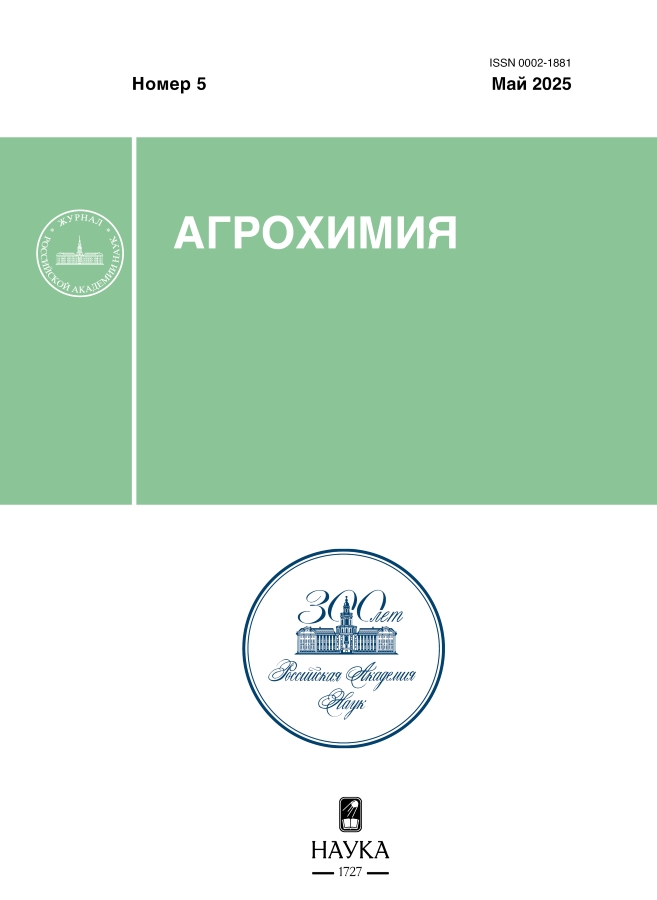About the balance of nutrients in modern agriculture
- 作者: Shafran S.A.1, Vinogradova S.B.1
-
隶属关系:
- The All-Russian Scientific Research Institute of Agrochemistry named after D.N. Pryanishnikov
- 期: 编号 5 (2025)
- 页面: 3-12
- 栏目: Articles
- URL: https://ruspoj.com/0002-1881/article/view/685252
- DOI: https://doi.org/10.31857/S0002188125050016
- EDN: https://elibrary.ru/TVSKVH
- ID: 685252
如何引用文章
详细
The results of studies on the balance of nutrients in agriculture are presented, which focus on the fact that, along with traditional organic fertilizers, other possible sources of organic matter, such as grain straw, were used. According to the regulations, the average nutrient removal of grain crops by straw in Russia is: nitrogen – 6.7, phosphorus – 2.1 and potassium – 12.8 kg/ton. Knowing the grain yield, it is possible to determine the amount of these nutrients, which will be returned to the soil with this source. Using these data, it is possible to determine its role in changing the nutrient balance in the soils of Russia in comparison with previously accepted methods of its determination. Calculations performed to determine the balance of nitrogen, phosphorus and potassium in agriculture in Russia, the Non-Chernozem zone as a whole and in its various regions where crops are cultivated have shown that in the Russian Federation, with a 50% use of straw for fertilizer, it will be compensated for nitrogen by 44, phosphorus by 51, and potassium – by 35%, which is 7, 14, 18%, respectively, more than the option without adding straw. For the Non-Chernozem zone, these figures were 9, 12, and 21%, respectively.
全文:
作者简介
S. Shafran
The All-Russian Scientific Research Institute of Agrochemistry named after D.N. Pryanishnikov
编辑信件的主要联系方式.
Email: shafran38@mail.ru
俄罗斯联邦, Pryanishnik str. 31a, Moscow 127550
S. Vinogradova
The All-Russian Scientific Research Institute of Agrochemistry named after D.N. Pryanishnikov
Email: shafran38@mail.ru
俄罗斯联邦, Pryanishnik str. 31a, Moscow 127550
参考
- Постников А.В., Шафран С.А. Баланс питательных веществ // Земледелие. 1968. № 10. С. 21–25.
- Шафран С.А., Ваганов Н.А. Баланс питательных веществ в севооборотах и их продуктивность на различных почвах // Химия в сел. хоз-ве. 1980. № 10. С. 29–33.
- Шафран С.А. Влияние длительного применения минеральных удобрений на продуктивность севооборотов и агрохимические показатели почв // Химия в сел. хоз-ве. 1981. № 10. С. 49–52.
- Нормативы выноса элементов питания сельскохозяйственными культурами. М.: ЦИНАО, 1991. 65 с.
- Нормативные показатели содержания азота, фосфора и калия в органических удобрениях и использование их сельскохозяйственными культурами на 1991–1995 гг. М.: ВИУА, 1991. 56 с.
- Постников А.В., Шафран С.А. Временные нормативы затрат удобрений на проведение работ по комплексному агрохимическому окультуриванию полей. М.: ВНИИПТИХИМ, 1982. 10 с.
- Сычев В.Г., Лошаков В.Г., Мерзлая Г.Е. Воспроизводство плодородия почвы при зерновой специализации в Центральном районе Нечерноземной зоны. М.: ВНИИА, 2012. 48 с.
- Мерзлая Г.Е., Державин Л.М., Завалин А.А. Рекомендации по эффективному использованию соломы и сидератов в земледелии. М.: ВНИИА, 2012. 44 с.
- Нормативы выноса элементов питания сельскохозяйственными культурами. М.: ЦИНАО, 1991. 63 с.
- Сычев В.Г., Шафран С.А., Ильюшенко И.В. Применение минеральных удобрений и их эффективность в различных зонах России // Плодородие. № 3. 2022. С. 3–4.
补充文件









